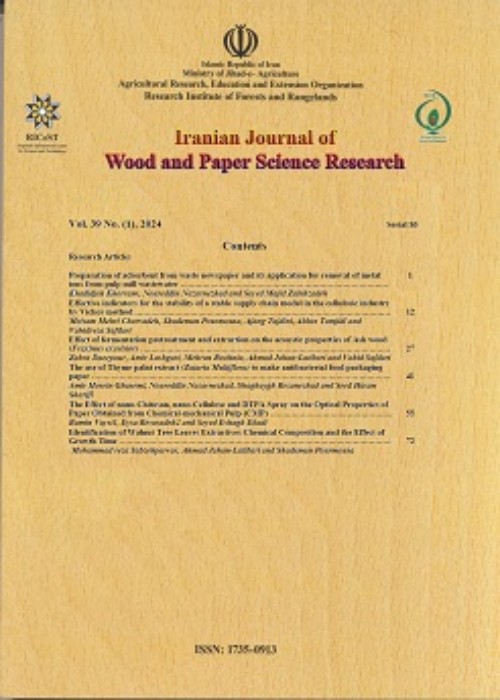Preparation of adsorbent from recycle newspaper and removal of metal ions from the pulp and paper mills wastewater
Author(s):
Article Type:
Research/Original Article (دارای رتبه معتبر)
Abstract:
Background and objectives
Contamination in pulp mill wastewater and subsequently surface and underground water sources contamination with heavy metals is one of the most important problems which threatens the health of human being and other creatures. These metals penetrate and pollute the soil and water. In this regard, this study investigated and determined heavy metals in the pulp mill wastewater before and after the wastewater treatment process. In this study the newspaper adsorbent was prepared and the efficiency of the adsorbent in the adsorption of copper, lead and cadmium metals was studied.Methodology
The adsorption experiments were performed to investigate the effect of the time of contact of the newspaper adsorbent and metals, and dose of the adsorbent. For this purpose, waste newspapers were first treated with sodium bicarbonate for one hour and then refluxed with 5% disodium hydrogen phosphate for 4 hours at 100 degrees Celsius and finally washed. Aqueous solutions with an initial concentration of 30 ppm for three metals lead, copper and cadmium were prepared by diluting the standard solution with distilled water. A specific amount of adsorbent was added to 10 ml of each solution and stirred in a mechanical shaker for specific times. Then they were filtered by filter paper purified and analyzed by atomic absorption spectroscopic device. After drying, the solid phase of the wastewater sample was subjected to acid digestion with nitric acid at a ratio of one to five. Then, the digested samples were analyzed with an atomic absorption spectrometer after washing.Results
The results of wastewater analysis in the basins before and after treatment showed that the amount of lead, copper and cadmium in the wastewater before treatment were 0.2129, 0.5983 and 0.0004 ppm, respectively. The amount of metals after the treatment process was 0.0469, 0.134 and 0.0001 ppm for lead, copper and cadmium, respectively. Also, according to the results, taking into account that the absorption rate was high and the same in the amount of absorbent used and the treatment times; the amount and time of the desired treatment in this experiment were not effective factors in the amount of metal absorption. Conclusion
The newspaper adsorbent is a good adsorbent for removing heavy metals from aqueous solutions due to high absorption capacity and low cost, which make the newspaper a potential adsorbent for the removal and wastewater treatment of the heavy metals. According to the results, the dosage and time of treatment with the newspaper adsorbent were not effective factors in metal removal.Keywords:
Language:
Persian
Published:
Iranian Journal of Wood and Paper Science Research, Volume:39 Issue: 1, 2024
Pages:
1 to 11
magiran.com/p2691951
دانلود و مطالعه متن این مقاله با یکی از روشهای زیر امکان پذیر است:
اشتراک شخصی
با عضویت و پرداخت آنلاین حق اشتراک یکساله به مبلغ 1,390,000ريال میتوانید 70 عنوان مطلب دانلود کنید!
اشتراک سازمانی
به کتابخانه دانشگاه یا محل کار خود پیشنهاد کنید تا اشتراک سازمانی این پایگاه را برای دسترسی نامحدود همه کاربران به متن مطالب تهیه نمایند!
توجه!
- حق عضویت دریافتی صرف حمایت از نشریات عضو و نگهداری، تکمیل و توسعه مگیران میشود.
- پرداخت حق اشتراک و دانلود مقالات اجازه بازنشر آن در سایر رسانههای چاپی و دیجیتال را به کاربر نمیدهد.
In order to view content subscription is required
Personal subscription
Subscribe magiran.com for 70 € euros via PayPal and download 70 articles during a year.
Organization subscription
Please contact us to subscribe your university or library for unlimited access!



